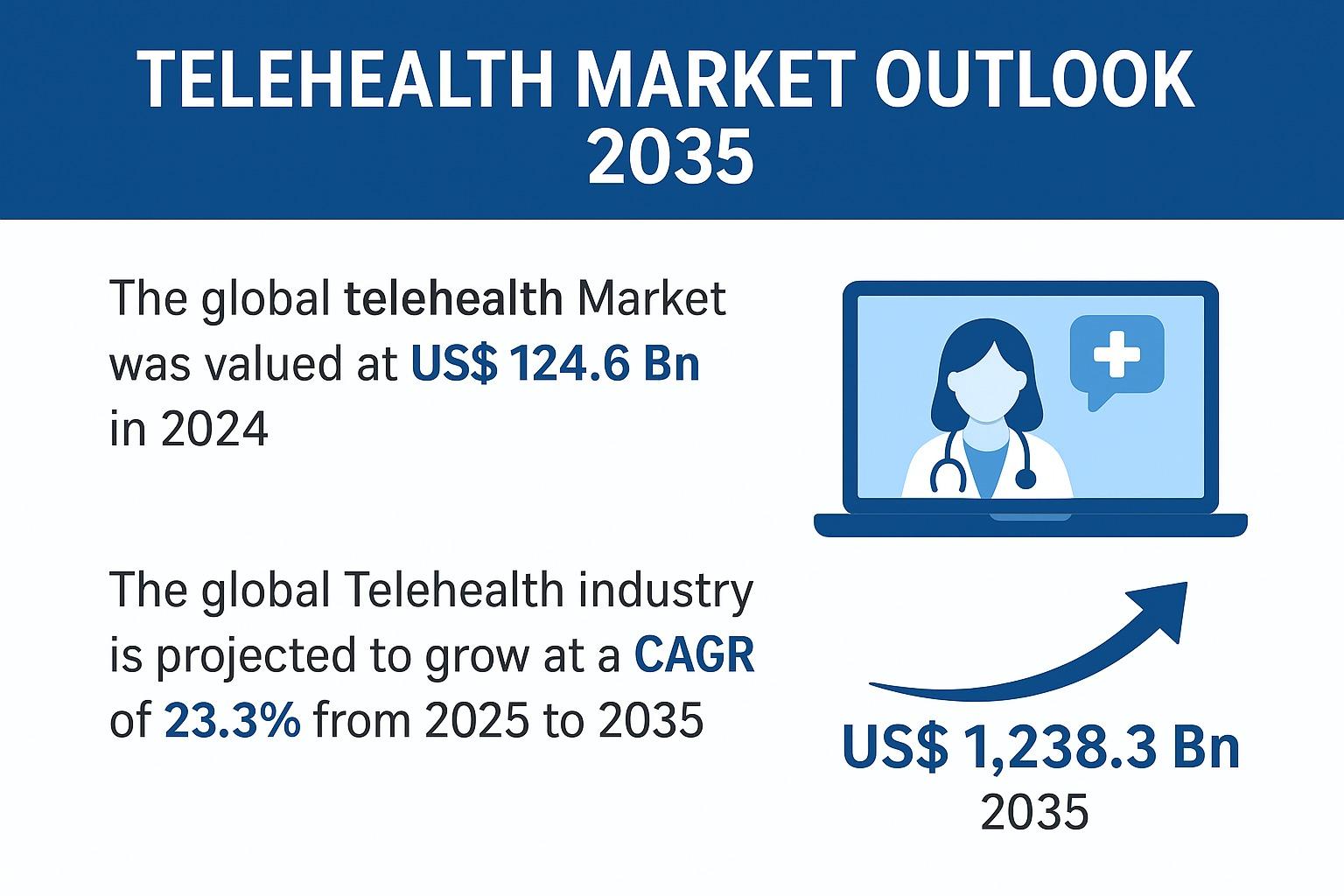The global telehealth market has witnessed exponential growth over the past decade, evolving into a crucial component of modern healthcare delivery. The telehealth market, valued at US$ 124.6 billion in 2024, is projected to expand at a CAGR of 23.3% from 2025 to 2035, reaching US$ 1,238.3 billion by the end of the forecast period. This surge is driven by technological advancements, increasing patient demand for remote care, and supportive healthcare policies worldwide.
Telehealth, defined as the delivery of healthcare services through digital communication technologies, encompasses virtual consultations, remote patient monitoring, and mobile health applications. The COVID-19 pandemic accelerated the adoption of telehealth, highlighting its potential to reduce exposure risks, maintain continuity of care, and improve patient convenience.
Analysts’ Viewpoint
Industry experts view telehealth as a transformative healthcare model capable of addressing the challenges posed by chronic diseases, aging populations, and limited healthcare accessibility. As smartphone penetration, broadband connectivity, and digital literacy increase globally, telehealth solutions are expected to penetrate deeper into rural and underserved regions. Moreover, the integration of advanced analytics and artificial intelligence is enabling personalized care and predictive monitoring, enhancing patient outcomes and operational efficiency.
Key Drivers and Trends
-
Rising Chronic Disease Burden & Aging Population
Chronic illnesses, including diabetes, cardiovascular diseases, and respiratory disorders, are increasing globally due to lifestyle changes and demographic shifts. The aging population further amplifies demand for continuous healthcare monitoring. Telehealth offers an economical and convenient solution, allowing real-time remote monitoring, timely interventions, and reduced hospital visits. This model particularly benefits patients with mobility constraints or those residing in rural regions with limited healthcare access. -
Cost-Efficiency & Enhanced Healthcare Accessibility
Traditional healthcare models entail substantial costs, including travel, facility charges, and opportunity costs from time off work. Telehealth mitigates these expenses by facilitating remote consultations and reducing hospitalization needs. Enhanced access to specialists, real-time monitoring, and flexible scheduling contribute to improved patient compliance and optimized resource utilization for healthcare systems. -
Technology Integration and Digital Transformation
The adoption of cloud-based platforms, mobile health apps, and wearable devices is driving innovation in telehealth. Services such as virtual consultations, remote monitoring, and teletherapy are witnessing increased demand. Real-time data transmission enables healthcare providers to make informed clinical decisions, while store-and-forward capabilities allow asynchronous consultations, expanding the scope of care delivery.
Segment Insights
-
By Component: Services dominate the telehealth market due to the comprehensive, patient-centric approach they provide. Virtual consultations, remote monitoring, and teletherapy ensure timely access to healthcare, particularly for chronic and acute conditions. Hardware and software components, including integrated and standalone solutions, support these services by enabling data collection, storage, and communication.
-
By Delivery Mode: Both cloud-based and on-premise solutions are gaining traction. Cloud platforms offer scalability, remote accessibility, and lower infrastructure costs, making them suitable for large-scale deployment, while on-premise systems provide security and compliance advantages.
-
By Application: Telehealth spans multiple specialties, including cardiology, radiology, psychiatry, dermatology, and urgent care. The demand is particularly high in remote ICU management, chronic disease monitoring, and mental health services, where continuous observation is critical.
-
By End-User: Providers, patients, and payers are significant stakeholders. Healthcare providers leverage telehealth for operational efficiency, patients benefit from convenience and timely care, and payers can reduce healthcare costs through decreased hospital admissions and emergency visits.
Regional Analysis
-
North America: The region leads the global telehealth market, supported by advanced healthcare infrastructure, high internet penetration, and regulatory support. Relaxed telehealth policies, reimbursement reforms, and significant investments in digital health have cemented North America’s leadership. Patients increasingly prefer virtual consultations, while providers adopt remote monitoring to manage chronic diseases efficiently.
-
Europe: Europe exhibits steady growth due to widespread healthcare digitization, government-backed initiatives, and increased awareness of telehealth benefits. Countries such as Germany, the U.K., and France are expanding telehealth services to bridge healthcare accessibility gaps.
-
Asia Pacific: APAC offers substantial growth potential, driven by rising smartphone adoption, increasing chronic disease prevalence, and expanding healthcare infrastructure. India, China, and Japan are witnessing rapid adoption, especially in rural and semi-urban regions.
-
Latin America and Middle East & Africa: These regions are expected to grow moderately, with telehealth adoption influenced by regulatory policies, digital infrastructure development, and public-private healthcare initiatives.
Competitive Landscape
Key players in the telehealth market are focusing on innovation, strategic partnerships, and technological advancement. Leading companies include:
-
Koninklijke Philips N.V. – Advanced telehealth platforms and remote monitoring solutions.
-
GE Healthcare – Integrated telehealth solutions across multiple specialties.
-
Cerner Corporation (Oracle) – Cloud-based health IT and telehealth services.
-
Siemens Healthineers – Digital health and remote patient monitoring systems.
-
Teladoc Health Inc. – Virtual care and teletherapy services.
-
American Well and Doctor on Demand – End-to-end telehealth services for patients.
These players are emphasizing AI-enabled diagnostics, wearable device integration, and cloud-based platforms to enhance service quality, expand patient reach, and gain competitive advantage.
Recent Developments
-
In April 2025, Australia introduced 1800MEDICARE, a nationwide health advice hotline with after-hours telehealth services, improving access to urgent care.
-
In January 2024, Aramark Healthcare+ launched a program connecting clinical nutritionists with hospital inpatients via telehealth, providing personalized care to support recovery.
Future Outlook
The telehealth market is poised for long-term growth, driven by increasing demand for remote care solutions, cost-effective healthcare delivery, and patient-centered services. Challenges, such as data security, interoperability, and regulatory compliance, remain critical but are expected to be addressed through technological innovation, policy evolution, and stakeholder collaboration.
As healthcare systems adapt to the digital era, telehealth is positioned to reshape patient engagement, enhance clinical efficiency, and deliver better health outcomes globally. Investments in infrastructure, AI-powered analytics, and remote monitoring solutions will further accelerate growth, solidifying telehealth as an indispensable component of modern healthcare.



